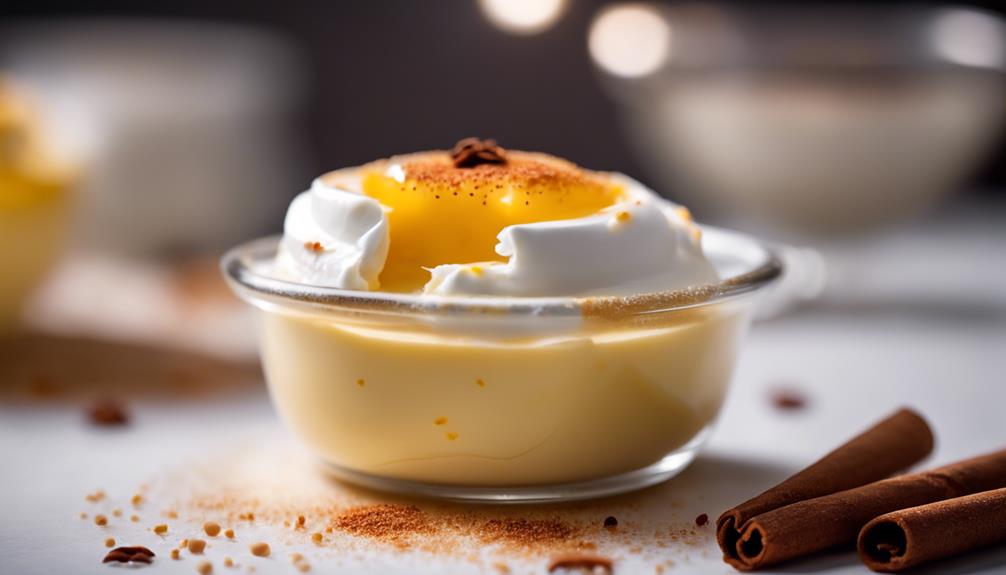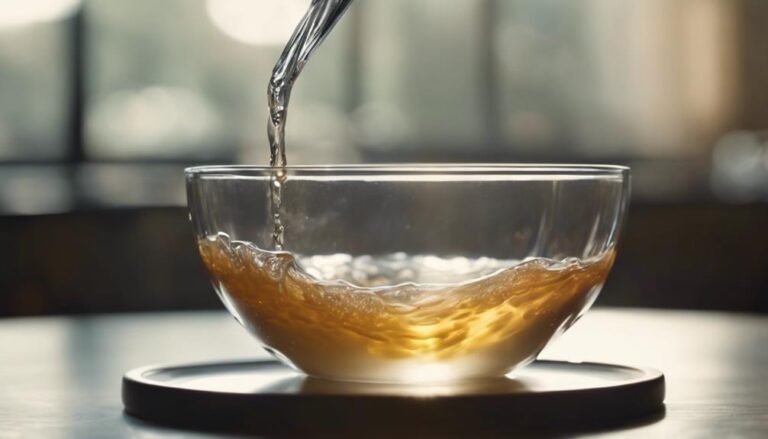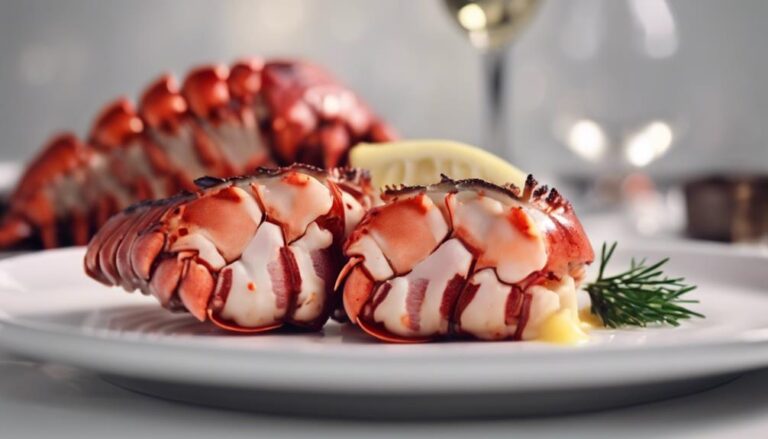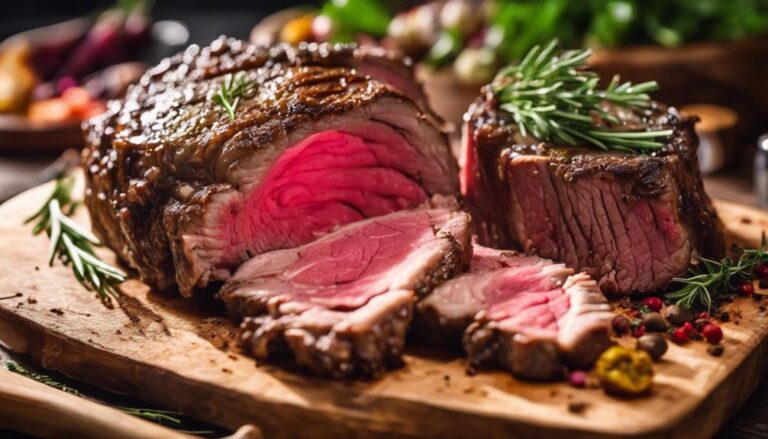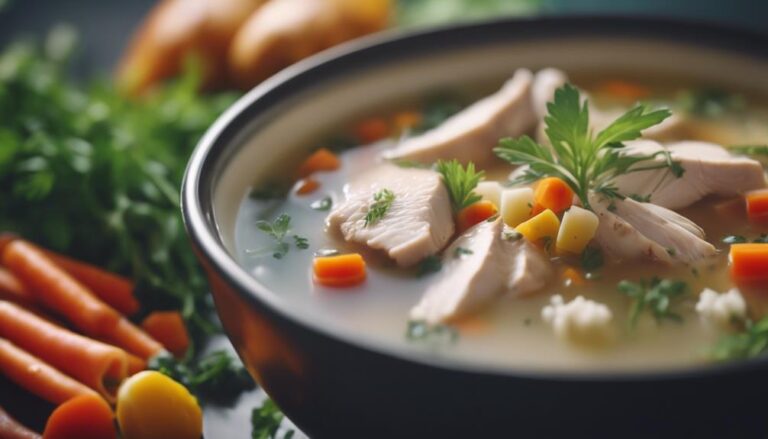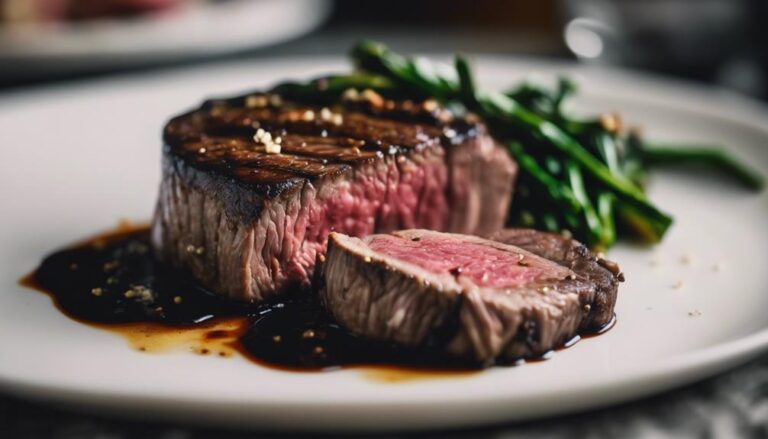Sous Vide Egg Custard: A Sweet Protein Treat
Achieve a silky smooth finish in Sous Vide Egg Custard by mastering meticulous temperature control. The sous vide method guarantees a velvety texture through gentle heat distribution and precise cooking temperatures. Control is key for even cooking and preventing overcooking. This method enhances flavors and guarantees dessert quality. Elevate your egg custard experience with this protein-rich and creamy treat.
What You Will Learn Here
- Sous vide cooking method ensures a smooth, velvety texture for the custard.
- Protein-rich ingredients in the custard offer a nutritious treat.
- Precise temperature control enhances the flavor profile of the dessert.
- Individual jar servings provide portion control benefits for a sweet protein snack.
- Minimal hands-on time required, ideal for easy preparation of a protein-rich dessert.
Egg Custard Origins
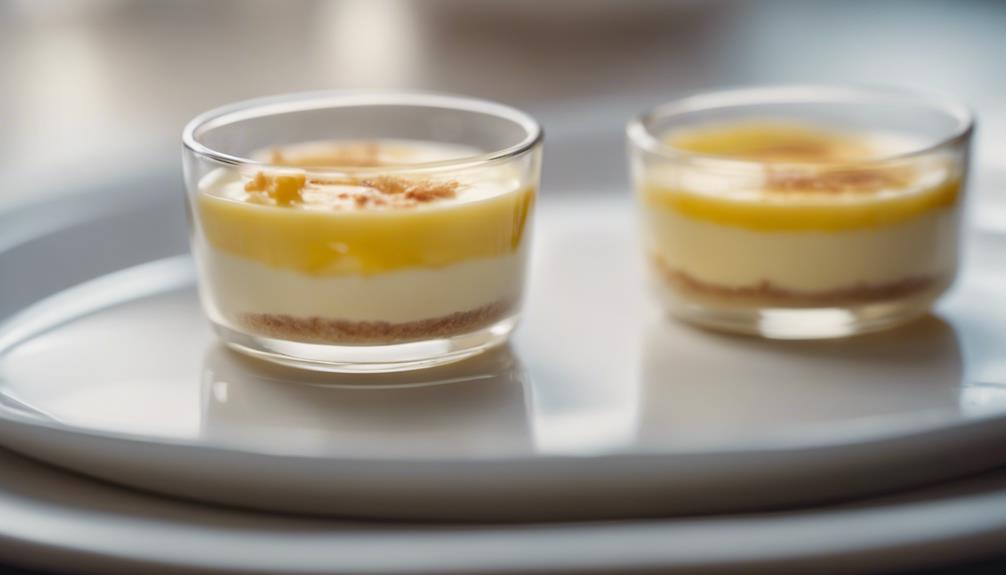
Egg custard has a rich historical background originating in medieval Europe, enjoyed by individuals across different social classes.
Traditional custard recipes typically consist of eggs, sugar, and milk or cream, resulting in a luscious, creamy dessert.
Cultural variations of egg custard, like creme brulee and flan, offer unique flavor profiles and textures depending on regional influences.
Egg Custard History
With origins dating back to ancient Rome and China, egg custard emerged as a luxurious culinary delight, incorporating a blend of sweeteners and spices to create a creamy and satisfying dessert.
This historical sweet treat was highly esteemed for its richness and versatility, offering a delightful combination of protein and sweetness.
Over time, traditional egg custards evolved into various regional versions, each adding its own unique twist to the classic recipe.
The use of eggs in custards not only provided a velvety texture but also contributed to its nutritional value, making it a popular choice for a decadent yet nourishing dessert.
Today, egg custards continue to be cherished globally, showcasing the enduring appeal of this timeless delicacy.
Traditional Custard Recipes
Traditional custard recipes, originating from various cultures around the world, have stood the test of time with their rich and creamy textures achieved through precise cooking techniques. These recipes, commonly featuring eggs, milk, and sugar, are prominent in European cuisine and have been cherished for centuries.
The smooth consistency of egg custard is a result of meticulous cooking methods like baking or steaming, ensuring a velvety finish. Flavorings such as vanilla, nutmeg, or citrus zest are often incorporated into classic custard recipes to enhance the overall taste profile.
Whether enjoyed as a standalone dessert or used as a filling, traditional egg custards continue to be a beloved choice for those seeking a delightful and indulgent treat.
Cultural Variations
Originating in various regions worldwide, egg custard exhibits cultural variations that showcase unique flavors and textures influenced by local ingredients and culinary traditions. Here is a breakdown of some cultural variations of egg custard desserts:
| Region | Egg Custard Variation | Key Features |
|---|---|---|
| China | Egg Custard Tarts | Flaky crust, silky smooth custard filling |
| Britain | Creamy Custard | Staple in custard tarts, trifle, bread pudding |
| Spain | Crema Catalana | Caramelized sugar topping similar to crème brûlée |
| Middle East | Mahalabiya | Milk-based custard with rose water, nuts, chilled |
These variations highlight the diverse culinary influences shaping the delightful world of egg custard desserts.
Egg Custard Sweeteners
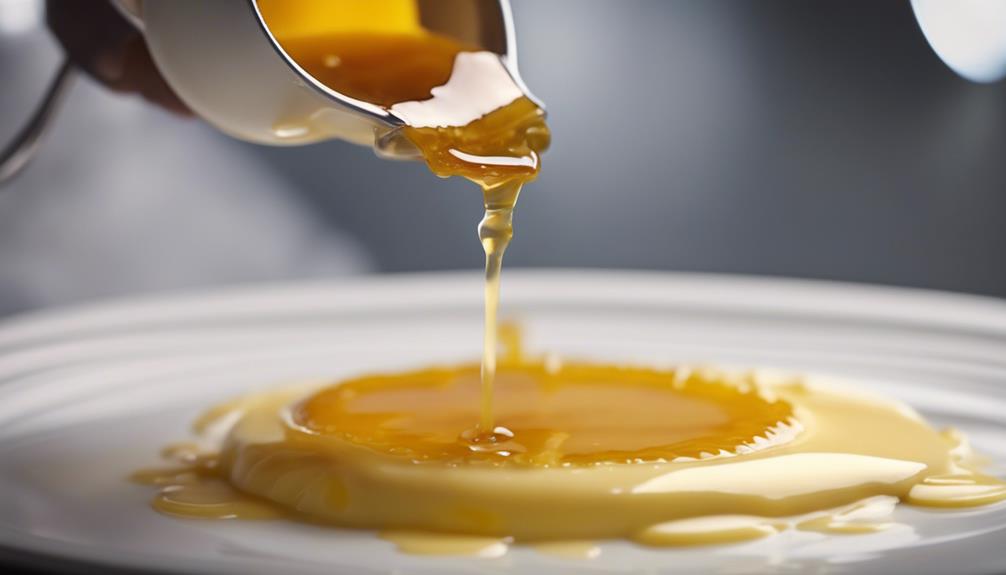
For egg custards, selecting the appropriate sweetener plays a significant role in determining the flavor profile and sweetness level of the final dish. When choosing a sweetener for your sous vide egg custard, consider the following:
- Sugar: Traditional white or brown sugar is a common choice for egg custards, providing a balanced sweetness and helping to achieve a smooth texture.
- Honey and Maple Syrup: Natural sweeteners like honey and maple syrup can add complexity and depth of flavor to the custard, enhancing its overall taste profile.
- Artificial Sweeteners: For those looking to reduce sugar intake, artificial sweeteners offer a low-calorie alternative without compromising sweetness.
Experimenting with different sweeteners allows you to customize your custard to suit your taste preferences. Keep in mind that some sweeteners may caramelize differently during cooking, impacting the color and texture of the final custard. Choose wisely to achieve the perfect balance of sweetness and flavor in your sous vide egg custard.
Custard With Sous Vide
When making custard with sous vide, you can achieve a smooth texture that's consistent and velvety every time.
The precise temperature control of sous vide cooking guarantees a silky pudding or flan that's rich and flavorful.
Experimenting with different flavors and ingredient quantities allows for customized results to suit your preferences.
Smooth Sous Vide Custard Recipe
To achieve a velvety smooth texture in your sous vide custard, precise temperature control is crucial throughout the cooking process. When making a smooth sous vide custard, consider the following:
- Temperature Consistency: Maintaining a stable water bath temperature guarantees even cooking and a creamy texture.
- Quality Ingredients: Opt for fresh eggs and high-grade vanilla extract to enhance the custard's flavor profile.
- Chilling Time: Allowing the custard to set in the refrigerator post-cooking helps achieve the desired smooth consistency.
Silky Sous Vide Pudding
Achieving a velvety smooth texture in your sous vide custard hinges on precise temperature control and the use of quality ingredients. When making silky sous vide pudding, remember these essential points:
- Utilize a sous vide machine to maintain a constant temperature for the custard in the sous.
- Prevent thermal shock by gradually cooling the custard after cooking.
- Enhance the flavor profile by caramelizing sugar to add a rich depth to your dessert.
Velvety Sous Vide Flan
For achieving the perfect velvety texture in your sous vide flan, precise temperature control and quality ingredients are essential elements to take into account. When preparing velvety sous vide flan, remember the following:
- Sous Vide: Utilize the sous vide method for consistent and controlled cooking.
- Creamy Custard: Achieve a luxurious and creamy custard texture.
- Flavor Customization: Experiment with various flavorings like vanilla, citrus, or spices to add a unique touch to your flan.
Sous Vide Custard Consistency
When considering the points of creamy custard texture, perfectly set consistency, and a silky smooth finish, sous vide cooking is essential.
Sous vide guarantees that the custard is cooked uniformly without the risk of curdling or overcooking.
This method ensures a velvety custard with a consistent texture every time, providing a foolproof way to achieve the desired results.
Creamy Custard Texture
To attain a consistently creamy custard texture through sous vide cooking, precise temperature control is essential for the entirety of the cooking duration. The immersion circulator plays a pivotal role in maintaining the desired temperature range, preventing overcooking and ensuring a smooth and velvety custard consistency.
Vacuum sealing the custard ingredients in jars or bags before sous vide cooking eliminates the risk of curdling or scrambling, resulting in a silky texture. The controlled environment of the water bath in sous vide cooking enhances custard consistency, allowing for a slow and gentle cooking process that promotes even and smooth setting.
This method yields a luxurious and rich texture in the custard, providing an ideal dessert experience for your guests.
Perfectly Set Consistency
Achieving the ideal set consistency in sous vide custards requires meticulous temperature control throughout the cooking process. Sous vide cooking maintains precise temperatures, ensuring a smooth and creamy texture in custards.
By controlling the heat evenly through a water bath, sous vide prevents overcooking or undercooking, resulting in a firm yet delicate custard. The controlled temperature eliminates the risk of curdling or scrambling, guaranteeing a silky-smooth texture.
This method allows for the custard to reach its perfect consistency without compromising its velvety mouthfeel. The outcome is a decadent dessert option that promises a luxurious experience, making sous vide custards a delightful treat for those seeking a perfectly set and creamy indulgence.
Silky Smooth Finish
For achieving a silky smooth finish in your sous vide custard, meticulous temperature control is essential. Sous vide cooking maintains precise temperatures, ensuring a velvety texture in your custard.
The consistent and gentle heat distribution in sous vide cooking plays a vital role in achieving the perfect custard consistency. By preventing overcooking, curdling, or scrambling, the sous vide technique results in a luxurious, creamy mouthfeel.
The controlled cooking environment of sous vide enhances custard consistency by eliminating hot spots and guaranteeing even cooking throughout.
Embrace the sous vide method for your custards to enjoy a silky smooth finish that delights the palate with its velvety texture.
Final Thoughts
In considering the overall outcome of preparing sous vide egg custard, it's clear that the precise cooking method truly guarantees the dessert's quality and consistency. Sous vide cooking ensures that the protein-rich egg custard maintains its creamy and rich texture, thanks to the controlled temperature water bath. This method guarantees even and consistent cooking, enhancing both the flavors and texture of the custard to perfection.
The convenience of preparing individual jar servings of sous vide egg custard not only offers portion control benefits but is also ideal for entertaining guests. The sous vide technique prevents overcooking, resulting in a smooth, creamy custard that requires minimal hands-on time. This dessert provides a delectable and satisfying treat that's sure to impress those you serve.
Frequently Asked Questions
Can You Overcook Custard in Sous Vide?
Yes, you can overcook custard in sous vide. Texture control, flavor retention, time efficiency, and consistency challenge are influenced. Monitoring temperature and cooking times is essential to prevent overcooking, ensuring a smooth, creamy texture.
At What Temperature Does Egg Custard Thicken?
To thicken egg custard, egg proteins coagulate between 160-170°F, forming a gel structure. Precise temperature control during cooking is essential for achieving the desired consistency. Monitor closely to avoid overheating, ensuring a smooth texture.
At What Temperature Does Custard Curdle?
To prevent custard curdling, maintain precise temperature control under 185°F. Rapid changes or high heat can cause grainy texture. Sous vide techniques help with consistency. Egg yolks are sensitive, denaturing proteins when overheated. Keep it smooth and creamy.
Is Sous Vide Good for Meal Prep?
For meal prep, sous vide offers benefits including precise cooking techniques, consistent flavors, and easy portioning. It's excellent for storing custard, with jars lasting up to 2 weeks. Reheat for quick meals.
Conclusion
To sum up, sous vide egg custard offers a precise and consistent way to create a sweet protein treat. By using this cooking method, you can achieve a smooth and creamy texture that's sure to satisfy your dessert cravings.
Experiment with different sweeteners to customize the flavor to your liking and enjoy a delicious and nutritious custard every time. Sous vide egg custard is a must-try for any dessert enthusiast looking for a new culinary experience.
